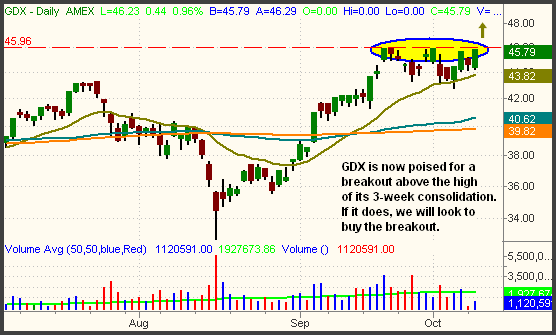| The Wagner Daily ETF Report for October 11 |
| By Deron Wagner |
Published
10/11/2007
|
Stocks
|
Unrated
|
|
|
|
The Wagner Daily ETF Report for October 11
Stocks gapped marginally lower yesterday morning, fell to new intraday lows just after mid-day, then recovered in the final ninety minutes of trading. The major indices finished with mixed results, most closing relatively near the flat line. Blue chips lagged, causing the Dow Jones Industrial Average to lose 0.6%. The S&P 500 slipped just 0.2%. A resumption of strength in the Biotech sector helped the Nasdaq Composite to gain 0.3%. Both the small-cap Russell 2000 and S&P Midcap 400 indexes slipped 0.1%. Stocks primarily settled in the upper third of their intraday ranges, making it the second consecutive day in which the broad market shook off early losses by showing strength into the close.
Total volume in the Nasdaq swelled 12%, enabling the tech-heavy index to bag its second straight "accumulation day." Total volume in the NYSE, was 2% lighter than the previous day's level, but that's a positive considering the S&P and Dow also closed lower. Over the past two weeks, the Nasdaq has flashed two "accumulation days" and two "distribution days." This indicates a bit of indecision amongst institutional players. However, with volume remaining below average levels the entire time, the effect of the higher volume gains and losses is somewhat diminished.
Yesterday, the Gold and Silver Index ($XAU) was the top performer of the major industries we follow on a daily basis. Not only did the StreetTRACKS Gold Trust (GLD) move higher, but our long entry in the Market Vectors Gold Miners (GDX) also triggered when it rallied above the high of its recent range. To refresh your mind, below is the daily chart we showed yesterday, which preceded the subsequent breakout above the high of its three-week consolidation:

Because it gapped higher on the open, we used the MTG Opening Gap Rules to manage our entry, rather than buying immediately on the open. Due to large changes in overnight supply or demand, both the major market indices and individual stocks will often open much higher or lower than where they closed the previous day, which is known as a "gap." Buying or selling short a stock that hits its trigger price due to an opening gap is sometimes riskier than entering a stock that trades through its trigger price in an orderly fashion. Likewise, open positions will sometimes gap open beyond their stop prices, but immediately reverse back in the right direction. Therefore, we have instituted the following rules to manage positions that gap open beyond their trigger or stop prices. Below is a basic summary of how we apply the Opening Gap Rules:
Stocks that gap open beyond their trigger prices: For a long setup, we only buy the ETF if it subsequently sets a new high after the first 20 minutes of trading. For a short setup, we only sell short the ETF if it subsequently sets a new low after the first 20 minutes of trading. In both cases, the ETF must exceed its 20-minute high (for longs) or 20-minute low (for shorts) by at least 10 cents before we will enter the position. Note that any opening gap of less than 10 cents above or below the trigger price will not prompt use of the gap rules.
Stocks that gap open beyond their stop prices: If a long position gaps down to open at or below its stop price, we continue to hold the stock for the first 20 minutes of trading, at which point the new stop price is adjusted to 10 cents below the low of the first 20 minutes. For short positions, we adjust the stop to 10 cents above the high of the first 20 minutes.
The above rules summarize how we typically manage gaps, and are designed to keep you out of trouble by preventing entries or exits of a trade at the worst prices of the day. However, just like every other rule in trading, there are always exceptions to these rules that will enable experienced traders to occasionally deviate from these rules with high success rates. These are nuances that cannot be taught, but can only be learned through experience. We follow these rules every day, unless an explanation is provided to our subscribers otherwise. These rules are designed to avert major losses, which is much more important than whether or not some profit is occasionally left on the table.
On a technical level, nothing has really changed since yesterday. The major indices remain overextended away from significant support levels, but there has been no catalyst for the current upward momentum to fade. Continue keeping a close eye on the performance of the Nasdaq Composite. With it trying to move above the upper channel resistance of its primary uptrend, sellers could logically sell into strength near this area. Since the Nasdaq has been the leader on the way up, the other indexes are also sure to correct when the Nasdaq eventually does.
Open ETF positions:
Long - GDX, LQD
Short - (none)
Deron Wagner is the Founder and Head Trader of both Morpheus Capital LP, a U.S. hedge fund, and Morpheus Trading Group, a trader education firm launched in 2001 that provides daily technical analysis of the leading ETFs and stocks. For a free trial to the full version of The Wagner Daily or to learn about Wagner's other services, visit MorpheusTrading.com or send an e-mail to deron@morpheustrading.com.
|